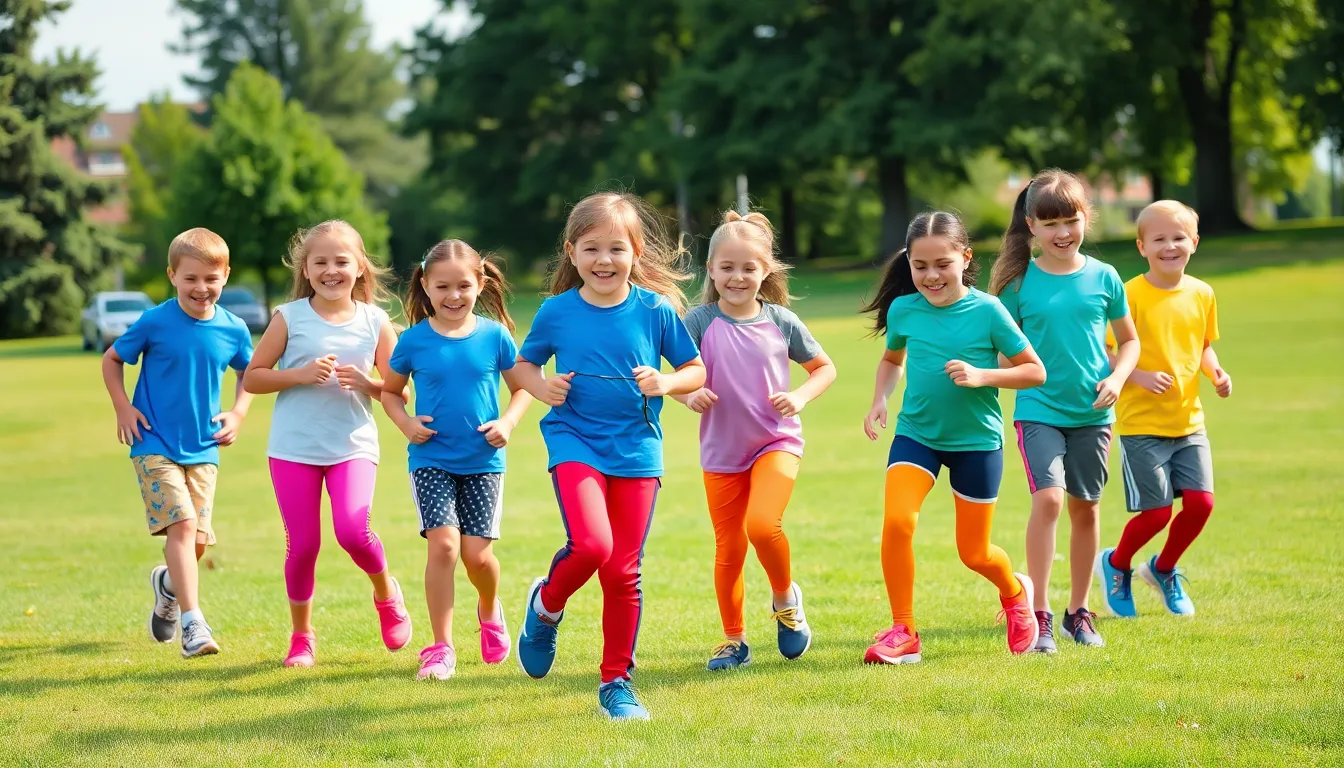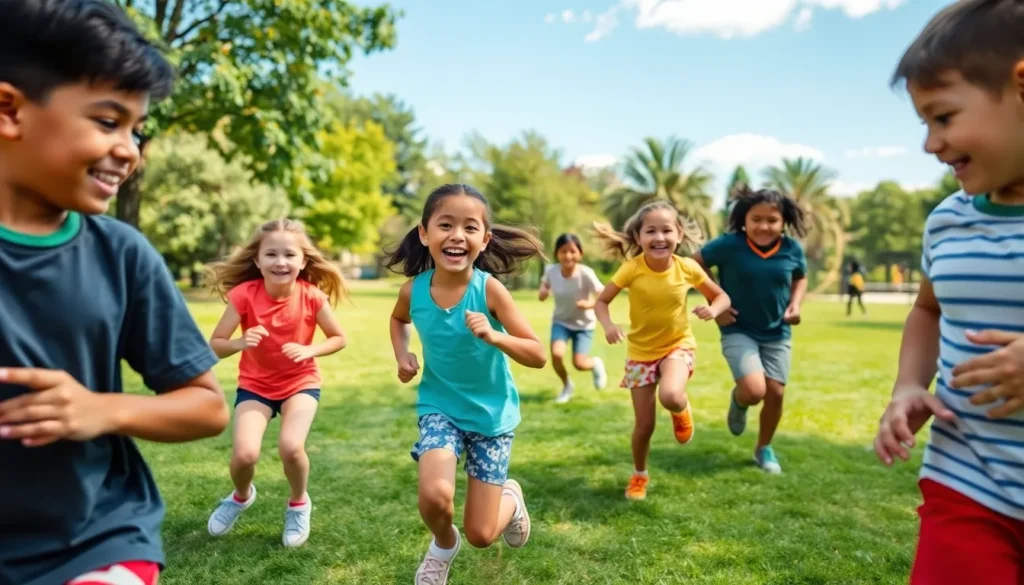In a world where video games reign supreme and couch cushions double as forts, getting the youth moving can feel like an uphill battle. But fear not! Youth fitness training isn’t just about sweating it out in a gym; it’s about turning exercise into an adventure. Imagine a place where kids can unleash their inner superheroes, all while building strength, endurance, and confidence.
Table of Contents
ToggleUnderstanding Youth Fitness Training
Youth fitness training plays a vital role in developing healthy habits. Engaging in physical activity fosters essential life skills while boosting overall well-being.
Importance of Physical Activity for Youth
Physical activity is crucial for youth development. It promotes physical health by improving cardiovascular fitness, strengthening bones, and supporting healthy weight management. Engaging in regular exercise reduces the risk of chronic diseases such as obesity and diabetes. Additionally, mental health significantly benefits from physical activity. Kids who exercise regularly exhibit lower levels of anxiety and depression, enhancing their mood and self-esteem. Social interactions during group activities or sports foster teamwork and leadership skills. Building body awareness through movement instills a lifelong appreciation for fitness.
Benefits of Structured Training Programs
Structured training programs offer numerous advantages. These programs provide a clear framework guiding youth through skill development and goal achievement. Safety is a priority, with trained professionals ensuring proper techniques reduce the risk of injury. Kids learn discipline and commitment by participating in consistent training schedules. Progress tracking enhances motivation, allowing youths to visualize improvements in their fitness levels. Team dynamics during structured activities promote camaraderie, helping children build lasting friendships. Structured training also encourages diverse physical skills, from strength training to endurance exercises, rounding out a well-balanced approach to fitness.
Designing a Youth Fitness Training Program

Creating an effective youth fitness training program involves integrating engaging and well-structured elements that resonate with young participants. Programs should encourage physical activity while fostering essential life skills.
Key Components of an Effective Program
Incorporating diverse elements into the training program enhances its effectiveness. A well-balanced regimen includes cardiovascular exercises, strength training, flexibility activities, and teamwork-oriented challenges. Establishing clear goals helps participants understand their objectives while tracking progress. Safety remains paramount, so supervision during activities prevents injuries. Encouragement and positive reinforcement motivate youth, helping them build confidence and enthusiasm for fitness.
Age-Appropriate Activities and Exercises
Selecting age-appropriate activities keeps participants engaged and motivated. For younger children, simple games like tag or obstacle courses cultivate enthusiasm. As participants grow, introducing more structured activities, such as age-specific strength training and aerobic sessions, supports skill development and physical conditioning. Besides, incorporating fun challenges ensures that fitness remains enjoyable rather than a chore. Adapting exercises to individual capabilities promotes inclusivity, fostering a sense of belonging among all participants.
Safety Considerations in Youth Fitness Training
Ensuring safety in youth fitness training involves careful planning and supervision. Protecting young participants from potential risks becomes a priority.
Importance of Supervision and Guidance
Supervision plays a critical role in youth fitness training. Trainers and coaches provide essential oversight, helping participants enjoy activities without injury. Experienced instructors can guide young athletes through proper techniques, ensuring exercises are performed safely. Structured environments benefit from ongoing mentorship, allowing youth to seek help when needed. Regular monitoring also encourages safe behavior and fosters discipline. Maintaining a low coach-to-participant ratio can enhance attention, addressing individual needs effectively. With adequate supervision, program success increases while minimizing risks.
Common Injuries and Prevention Strategies
Injuries commonly associated with youth fitness training include sprains, strains, and overuse injuries. Understanding these risks requires implementing effective prevention strategies. Stretching before activities promotes flexibility, reducing the chance of injury. Proper warm-ups prepare muscles and joints for physical exertion. Engaging participants in age-appropriate exercises discourages dangerous strain on developing bodies. Equipment should always fit properly, ensuring safety during activities. Educating youth about their physical limits empowers them to recognize signs of fatigue or discomfort. Consistently reviewing technique during training sessions helps identify and rectify unsafe practices early, significantly lowering injury risk.
Engaging Youth in Fitness Training
Engaging youth in fitness training requires innovative strategies and strong support systems. Creating an atmosphere that promotes enthusiasm enhances participation and commitment.
Strategies to Motivate Young Athletes
Motivating young athletes involves various fun strategies. Incorporating gamified workouts transforms exercise into a playful challenge. Including rewards, like badges or certificates, fosters a sense of achievement. Team-based activities encourage camaraderie, making fitness a social experience. Additionally, introducing friendly competitions can spark excitement and strengthen dedication. Focusing on personal goals enables young participants to track progress, fueling their motivation. Offering a mix of activities—such as dance, team sports, or obstacle courses—caters to diverse interests. Ultimately, providing consistent encouragement builds their confidence and encourages ongoing engagement.
The Role of Parental Support
Parental support plays a crucial role in youth fitness training. Actively participating in training sessions can inspire children and illustrate commitment. Setting a routine for exercise prompts consistent involvement and reinforces healthy habits. Parents can also engage in open discussions about fitness goals, emphasizing their importance. Celebrating achievements, whether big or small, nurtures motivation and enthusiasm. By attending events and competitions, parents show their investment in their child’s progress. Establishing a supportive environment at home, such as providing nutritious snacks or encouraging outdoor play, complements fitness training. Overall, strong parental involvement cultivates a positive attitude towards fitness and wellness in young athletes.
Youth fitness training is essential for nurturing healthy habits and life skills in children. By transforming workouts into engaging adventures and fostering a supportive environment, young participants can develop not only their physical abilities but also their confidence and teamwork skills.
Structured training programs play a crucial role in ensuring safety and promoting discipline. When designed thoughtfully, these programs can motivate youth to embrace fitness as a fun and rewarding part of their lives.
With the right approach and parental support, fitness training can become a lifelong journey for youth, paving the way for a healthier future. Emphasizing enjoyment and inclusivity will help cultivate a positive attitude towards physical activity, ensuring that children grow into active and healthy adults.




